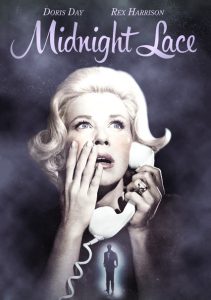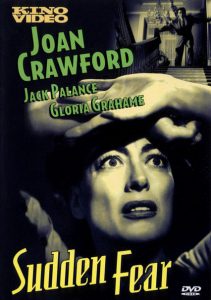Midnight Lace-1960
Director David Miller
Starring Doris Day, Rex Harrison
Scott’s Review #909
Reviewed June 13, 2019
Grade: B+
Midnight Lace (1960) is a straightforward psychological thriller made in cinematic history when the genre increased in popularity.
The film was influenced by the Alfred Hitchcock craze, which was front and center at this time, and a robust departure for its lead, Doris Day, who until this time mainly was nestled securely in the romantic comedy domain.
The film is a good watch and a challenging role for Day, who proves she has the acting chops to carry the movie.
Day portrays Kit, an American heiress, newly married to British financier Tony (Rex Harrison), residing together in London. When she is terrorized by an odd voice in a London park one misty night, her panic is dismissed as rubbish, and pranksters have their way with her.
When the threats return and escalate with telephone calls, Tony alerts the authorities, who question whether Kit may be imagining things or creating a panic to gain attention from her husband.
Tony, in turn, begins to ask the same questions.
Day, an American sweetheart and forever good girl was brave enough to tackle a role that was left of center for her. Despite her acceptable acting and impressive range during scenes of peril, Doris Day is still Doris Day, and it is tough to shake the image of her playing herself.
Attractive, Day is not the sexpot type, so a few scenes of her being flirty by attempting to seduce Tony with sexy nighties do not work so well. Day has never looked lovelier than she does in this picture.
The plot rolls along with fantastic glossy production values, and I never found myself tuning out or wondering when the film would end.
The drama heightens minute by minute, turning into a whodunit, while the film wisely never disqualifies whether Kit could be staging the shenanigans herself.
Did she fall into a bus, or was she pushed? Why did she hire someone to call her? Is the menacing voice disguised? The questions become more frequent as the film progresses, which is what good thrillers should do.
I figured out only half of the big reveal, but the other half caught me off guard, and the finale was climactic and satisfying.
The film belongs to Day, but the additions of Harrison and the legendary Myrna Loy add class and flavor to a movie that could have been dismissed as only cliched in lesser hands.
Harrison is effective as the concerned but stoic husband, and the audience wonders if Tony is involved in Kit’s stalking or if he is a caring man.
Does the subplot of a discovered embezzler in Tony’s company have anything to do with it? If so, how are the stories connected?
Handsome John Gavin, a Rock Hudson type who became famous for Psycho (1960), is a welcome addition as contractor Brian. He shows up at the right time to save Kit, making him a prime suspect.
Loy plays Kit’s Aunt Bea, who comes to town for a visit; the part is nothing special, but seeing the actress in whatever role she tackles is lovely.
Finally, Malcolm Stanley (Roddy McDowell) adds drama as a money-hungry man and son of Kit’s maid.
Characters are added to the story as potential suspects.
The viewer is treated to their share of exterior shots of London, which provides the film with enough British flavor, almost to forget that Day is American. With the additions of Scotland Yard and an Inspector, the British culture is firmly placed, adding a wonderful British element.
Tony and Kit are rich, so their lavish home and exclusive neighborhood are finely placed on display.
The film’s title is represented in a cute scene when Kit seductively holds up a sexy outfit she purchased for Tony. The scene seems straight out of the 1980s slick television movie thriller genre and is primed for the Lifetime television network.
This is not a criticism because the title works well and holds tantalizing darkness.
Midnight Lace (1960) is a nearly forgotten film that is a fine watch and a lovely tribute to Doris Day’s talents. She makes the film her own and is the main reason to watch it.
Though she does not sing or play the girl next door, she does turn in an above-average performance, showing her range as an actress. The rest of the film’s trimmings, especially the locale and the supporting actors, benefit the viewing pleasure the film possesses.
Oscar Nominations: Best Costume Design, Color

